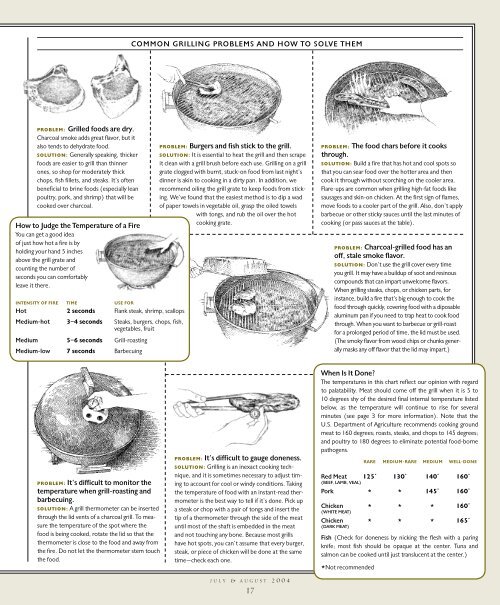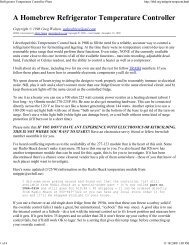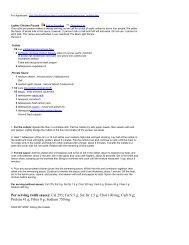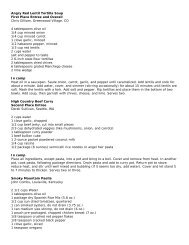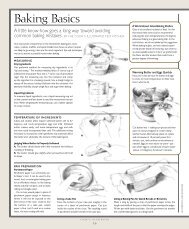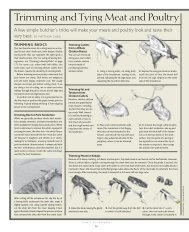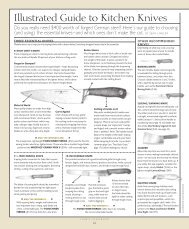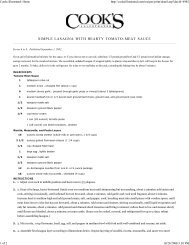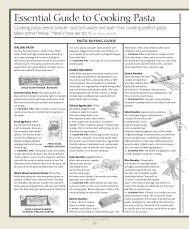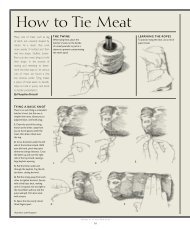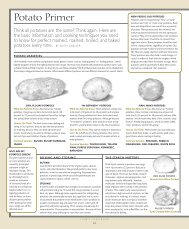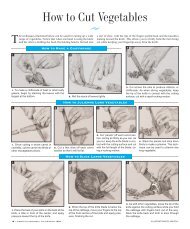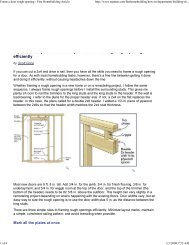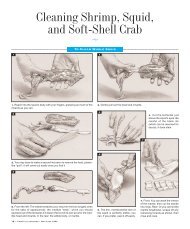16 Grilling Spread JA04 fpe - Tru-Burn
16 Grilling Spread JA04 fpe - Tru-Burn
16 Grilling Spread JA04 fpe - Tru-Burn
You also want an ePaper? Increase the reach of your titles
YUMPU automatically turns print PDFs into web optimized ePapers that Google loves.
COMMON GRILLING PROBLEMS AND HOW TO SOLVE THEM<br />
PROBLEM: Grilled foods are dry.<br />
Charcoal smoke adds great flavor, but it<br />
also tends to dehydrate food.<br />
SOLUTION: Generally speaking, thicker<br />
foods are easier to grill than thinner<br />
ones, so shop for moderately thick<br />
chops, fish fillets, and steaks. It’s often<br />
beneficial to brine foods (especially lean<br />
poultry, pork, and shrimp) that will be<br />
cooked over charcoal.<br />
How to Judge the Temperature of a Fire<br />
You can get a good idea<br />
of just how hot a fire is by<br />
holding your hand 5 inches<br />
above the grill grate and<br />
counting the number of<br />
seconds you can comfortably<br />
leave it there.<br />
INTENSITY OF FIRE TIME USE FOR<br />
Hot 2 seconds Flank steak, shrimp, scallops<br />
Medium-hot 3–4 seconds Steaks, burgers, chops, fish,<br />
vegetables, fruit<br />
Medium 5–6 seconds Grill-roasting<br />
Medium-low 7 seconds Barbecuing<br />
PROBLEM: Burgers and fish stick to the grill.<br />
SOLUTION: It is essential to heat the grill and then scrape<br />
it clean with a grill brush before each use. <strong>Grilling</strong> on a grill<br />
grate clogged with burnt, stuck-on food from last night’s<br />
dinner is akin to cooking in a dirty pan. In addition, we<br />
recommend oiling the grill grate to keep foods from sticking.<br />
We’ve found that the easiest method is to dip a wad<br />
of paper towels in vegetable oil, grasp the oiled towels<br />
with tongs, and rub the oil over the hot<br />
cooking grate.<br />
PROBLEM: The food chars before it cooks<br />
through.<br />
SOLUTION: Build a fire that has hot and cool spots so<br />
that you can sear food over the hotter area and then<br />
cook it through without scorching on the cooler area.<br />
Flare-ups are common when grilling high-fat foods like<br />
sausages and skin-on chicken. At the first sign of flames,<br />
move foods to a cooler part of the grill. Also, don’t apply<br />
barbecue or other sticky sauces until the last minutes of<br />
cooking (or pass sauces at the table).<br />
PROBLEM: Charcoal-grilled food has an<br />
off, stale smoke flavor.<br />
SOLUTION: Don’t use the grill cover every time<br />
you grill. It may have a buildup of soot and resinous<br />
compounds that can impart unwelcome flavors.<br />
When grilling steaks, chops, or chicken parts, for<br />
instance, build a fire that’s big enough to cook the<br />
food through quickly, covering food with a diposable<br />
aluminum pan if you need to trap heat to cook food<br />
through. When you want to barbecue or grill-roast<br />
for a prolonged period of time, the lid must be used.<br />
(The smoky flavor from wood chips or chunks generally<br />
masks any off flavor that the lid may impart.)<br />
PROBLEM: It’s difficult to monitor the<br />
temperature when grill-roasting and<br />
barbecuing.<br />
SOLUTION: A grill thermometer can be inserted<br />
through the lid vents of a charcoal grill. To measure<br />
the temperature of the spot where the<br />
food is being cooked, rotate the lid so that the<br />
thermometer is close to the food and away from<br />
the fire. Do not let the thermometer stem touch<br />
the food.<br />
PROBLEM: It’s difficult to gauge doneness.<br />
SOLUTION: <strong>Grilling</strong> is an inexact cooking technique,<br />
and it is sometimes necessary to adjust timing<br />
to account for cool or windy conditions. Taking<br />
the temperature of food with an instant-read thermometer<br />
is the best way to tell if it’s done. Pick up<br />
a steak or chop with a pair of tongs and insert the<br />
tip of a thermometer through the side of the meat<br />
until most of the shaft is embedded in the meat<br />
and not touching any bone. Because most grills<br />
have hot spots, you can’t assume that every burger,<br />
steak, or piece of chicken will be done at the same<br />
time—check each one.<br />
J U L Y & A U G U S T 2 0 0 4<br />
17<br />
When Is It Done?<br />
The temperatures in this chart reflect our opinion with regard<br />
to palatability. Meat should come off the grill when it is 5 to<br />
10 degrees shy of the desired final internal temperature listed<br />
below, as the temperature will continue to rise for several<br />
minutes (see page 3 for more information). Note that the<br />
U.S. Department of Agriculture recommends cooking ground<br />
meat to <strong>16</strong>0 degrees; roasts, steaks, and chops to 145 degrees;<br />
and poultry to 180 degrees to eliminate potential food-borne<br />
pathogens.<br />
RARE MEDIUM-RARE MEDIUM WELL-DONE<br />
Red Meat 125˚ 130˚ 140˚ <strong>16</strong>0˚<br />
(BEEF, LAMB, VEAL)<br />
Pork * * 145˚ <strong>16</strong>0˚<br />
Chicken * * * <strong>16</strong>0˚<br />
(WHITE MEAT)<br />
Chicken * * * <strong>16</strong>5˚<br />
(DARK MEAT)<br />
Fish (Check for doneness by nicking the flesh with a paring<br />
knife; most fish should be opaque at the center. Tuna and<br />
salmon can be cooked until just translucent at the center.)<br />
* Not recommended


